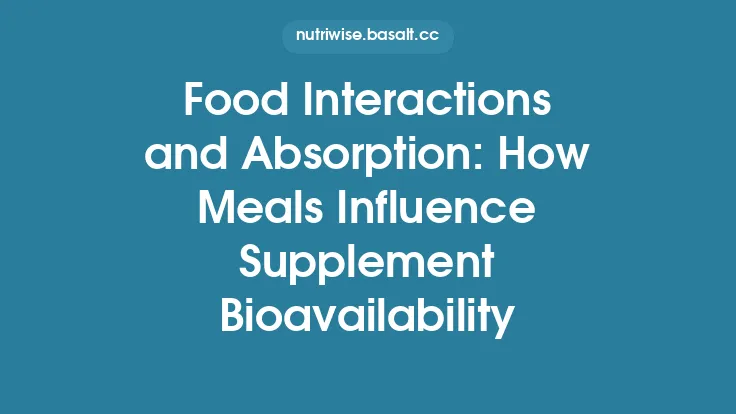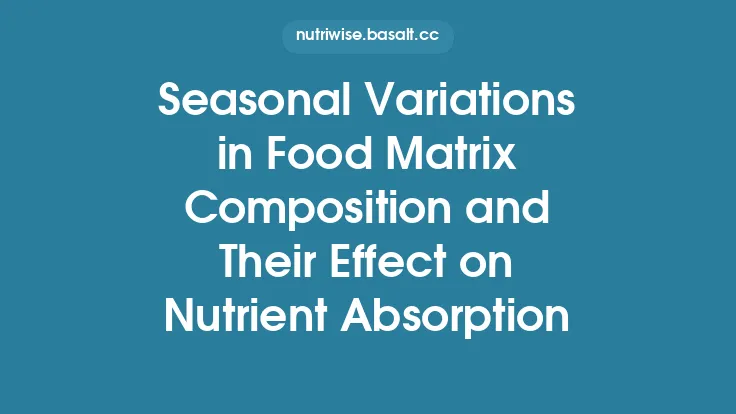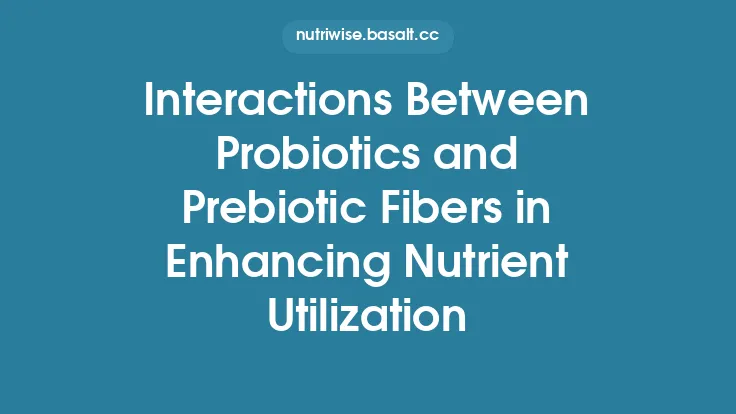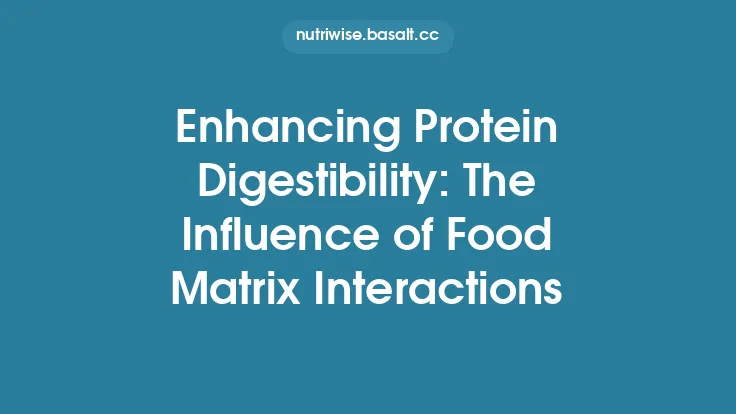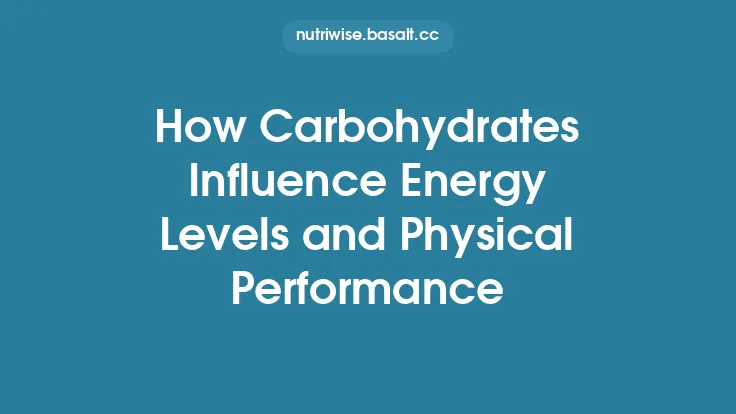Protein–carbohydrate interactions are a cornerstone of modern nutrition science, shaping how the body perceives, digests, and metabolizes the foods we eat. While carbohydrates are the primary drivers of post‑prandial blood glucose excursions, the presence of protein—whether as free amino acids, peptides, or intact proteins—can markedly modulate the magnitude and timing of the glycemic response. Understanding these mechanisms is essential for designing meals that support metabolic health, improve satiety, and reduce the risk of chronic diseases such as type 2 diabetes.
Overview of Protein–Carbohydrate Complexes
1. Physical association in the food matrix
In many whole foods, proteins and carbohydrates coexist in close proximity, forming structural networks that affect the accessibility of starch granules to digestive enzymes. For example, the protein matrix surrounding wheat endosperm starch can limit amylase penetration, slowing starch hydrolysis. In legumes, the protein‑rich cotyledon envelops starch granules, creating a natural barrier that reduces the rate of glucose release.
2. Chemical binding and complex formation
Beyond simple physical entrapment, proteins can bind carbohydrates through non‑covalent interactions (hydrogen bonding, electrostatic forces, and hydrophobic contacts). These protein–carbohydrate complexes can be stable enough to survive gastric conditions, only dissociating in the small intestine where pH and enzymatic activity are higher. The formation of such complexes is influenced by the amino‑acid composition of the protein (e.g., presence of positively charged residues) and the degree of carbohydrate polymerization (e.g., amylose vs. amylopectin).
3. Co‑digestion and enzymatic competition
During digestion, proteases (pepsin, trypsin, chymotrypsin) and carbohydrases (α‑amylase, maltase, sucrase) act concurrently. The simultaneous presence of protein can compete for water and alter the micro‑environment, affecting enzyme kinetics. Moreover, peptide fragments generated from protein hydrolysis can act as allosteric modulators of carbohydrate‑digesting enzymes, either inhibiting or enhancing their activity.
Physiological Basis of the Glycemic Response
1. Rate of glucose appearance (Ra) in the bloodstream
The post‑prandial glycemic curve is determined by the rate at which glucose appears in the portal circulation (Ra) relative to the rate of glucose disposal (Rd). Protein can attenuate Ra by:
- Delaying gastric emptying, thereby slowing the delivery of carbohydrate to the duodenum.
- Reducing the effective surface area of starch granules available for amylolysis.
- Generating peptide fragments that inhibit α‑amylase or α‑glucosidase.
2. Incretin hormone modulation
Protein ingestion stimulates the release of gut hormones such as glucagon‑like peptide‑1 (GLP‑1) and glucose‑dependent insulinotropic polypeptide (GIP). These incretins enhance insulin secretion and suppress glucagon, contributing to a more controlled rise in blood glucose. The synergistic effect of protein‑induced incretin release and carbohydrate‑driven glucose absorption creates a smoother glycemic profile.
3. Insulinotropic amino acids
Certain amino acids (e.g., leucine, arginine, lysine) are potent insulin secretagogues. When consumed with carbohydrate, they amplify the insulin response, facilitating more rapid glucose uptake by peripheral tissues. This effect is particularly evident in mixed meals where the protein component is of high biological value.
Molecular Mechanisms of Interaction
1. Enzyme inhibition by peptide fragments
Research has identified specific peptide sequences that act as competitive inhibitors of α‑amylase. For instance, the dipeptide Lys‑Phe derived from soy protein hydrolysates exhibits a Ki in the low micromolar range, reducing the catalytic efficiency of amylase on starch substrates. Similar inhibitory effects have been observed for α‑glucosidase, where longer oligopeptides from whey protein can bind the active site and impede maltose hydrolysis.
2. Alteration of starch gelatinization
Proteins can interfere with the gelatinization process of starch during cooking. By forming a protein‑starch network, they raise the gelatinization temperature and limit the swelling of granules. This physical modification translates into a lower digestible carbohydrate fraction (resistant starch) and a blunted glycemic response.
3. Modulation of intestinal transporters
Amino acids and small peptides can influence the activity of sodium‑glucose cotransporter‑1 (SGLT1) and glucose transporter‑2 (GLUT2) on enterocytes. Studies using Caco‑2 cell monolayers have shown that high concentrations of leucine down‑regulate SGLT1 expression, reducing glucose uptake rates. Conversely, certain dipeptides may up‑regulate GLUT2, highlighting the nuanced interplay between protein‑derived metabolites and glucose transport.
4. Impact on hepatic glucose output
Protein‑induced glucagon secretion can stimulate hepatic gluconeogenesis, but the concurrent rise in insulin (via incretin and amino‑acid pathways) generally overrides this effect, leading to net glucose clearance. The balance between these hormones is a key determinant of the overall glycemic impact of a mixed meal.
Influence of Food Matrix and Processing
1. Thermal processing
Heat treatment (e.g., baking, extrusion) can denature proteins, exposing hydrophobic residues that enhance binding to starch. However, excessive heating may also cause Maillard reactions, forming protein‑sugar complexes that are less digestible and may further lower the glycemic index (GI) of the product.
2. Mechanical disruption
Grinding or milling reduces particle size, increasing the surface area of both protein and carbohydrate. While this can accelerate digestion, the presence of intact protein matrices can still provide a protective effect, especially when the protein is high in proline‑rich sequences that resist proteolysis.
3. Fermentation
Microbial fermentation of protein‑carbohydrate blends (e.g., sourdough bread) leads to partial hydrolysis of both macronutrients. The resulting short‑chain peptides and oligosaccharides can modulate enzyme activity and gut hormone release, often resulting in a lower post‑prandial glucose peak compared with non‑fermented equivalents.
4. Emulsification and encapsulation
Encapsulating carbohydrates within protein‑based carriers (e.g., whey protein isolates) creates a diffusion barrier that delays starch hydrolysis. This technology is increasingly used in functional foods aimed at glycemic control.
Clinical Implications and Dietary Strategies
1. Meal composition for glycemic management
- Protein‑rich breakfast: Adding 20–30 g of high‑quality protein (e.g., eggs, Greek yogurt, soy) to a carbohydrate‑based breakfast can reduce the post‑prandial glucose excursion by 15–30 % compared with carbohydrate alone.
- Balanced macronutrient distribution: A 1:1 ratio of protein to carbohydrate (by weight) is often cited as an effective strategy for blunting glucose spikes, especially in individuals with impaired glucose tolerance.
- Timing of protein intake: Consuming protein 10–15 minutes before a carbohydrate load can pre‑emptively stimulate incretin release, leading to a more moderated glucose rise.
2. Target populations
- Type 2 diabetes: Incorporating protein into meals has been shown to improve HbA1c levels over 12 weeks in randomized controlled trials, primarily through reduced post‑prandial peaks.
- Athletes: For endurance athletes, protein‑carbohydrate co‑ingestion not only supports glycogen replenishment but also moderates glycemic variability, which can be beneficial for performance consistency.
- Older adults: Protein‑enhanced meals can aid in maintaining muscle mass while also providing a smoother glycemic profile, reducing the risk of hypoglycemia associated with rapid glucose fluctuations.
3. Practical food examples
- Legume‑based salads: Chickpeas (protein + complex carbs) combined with leafy greens and a light vinaigrette.
- Dairy‑fruit smoothies: Greek yogurt blended with berries and a small amount of oats.
- Whole‑grain toast with nut butter: The combination of wheat starch and plant protein creates a sustained release of glucose.
Research Gaps and Future Directions
1. Precision nutrition
While the general principles of protein‑carbohydrate interaction are established, individual variability (genetic polymorphisms in amylase, SGLT1, or incretin receptors) remains underexplored. Future studies should integrate nutrigenomics to tailor protein‑carbohydrate ratios for personalized glycemic control.
2. Long‑term outcomes
Most existing data focus on acute post‑prandial responses. Longitudinal trials assessing the impact of sustained protein‑carbohydrate dietary patterns on insulin sensitivity, β‑cell function, and cardiovascular risk are needed.
3. Novel protein sources
Emerging plant‑based proteins (e.g., pea, lentil, insect) possess distinct amino‑acid profiles and structural properties that may interact differently with carbohydrates. Systematic evaluation of these novel proteins could expand the toolbox for glycemic management.
4. Microbiome interplay
Although the article avoids delving into probiotic‑prebiotic interactions, the gut microbiota can metabolize protein‑carbohydrate complexes into short‑chain fatty acids, which indirectly influence glucose homeostasis. Integrating microbiome analyses with protein‑carbohydrate studies will provide a more holistic view.
Conclusion
Protein–carbohydrate interactions represent a multifaceted mechanism that shapes the glycemic response through physical, chemical, and hormonal pathways. By influencing starch accessibility, enzyme activity, gut hormone secretion, and glucose transport, protein can attenuate the rate and magnitude of post‑prandial glucose appearance. Understanding these mechanisms enables nutrition professionals to design meals that harness the synergistic benefits of protein and carbohydrate, supporting metabolic health across diverse populations. Continued research—particularly in the realms of personalized nutrition, novel protein sources, and long‑term clinical outcomes—will refine our ability to leverage these interactions for optimal glycemic control.
